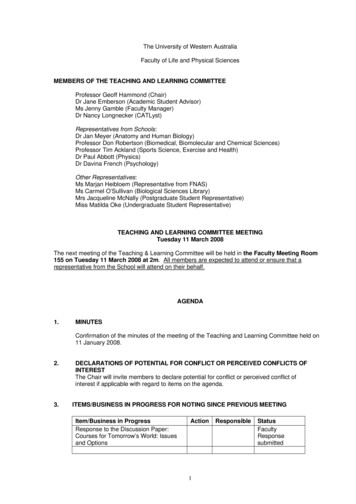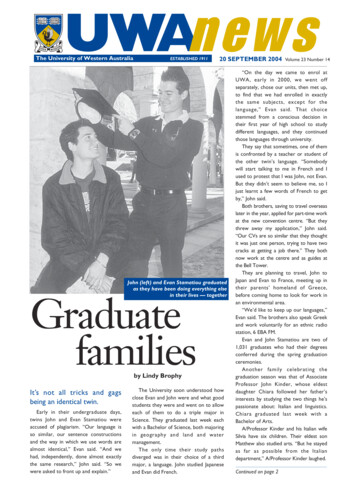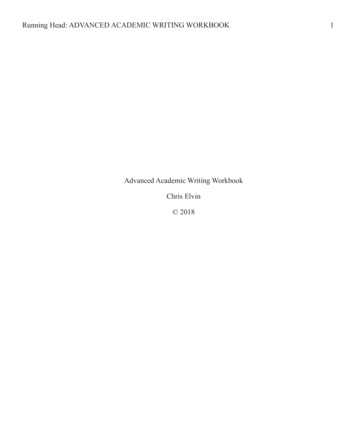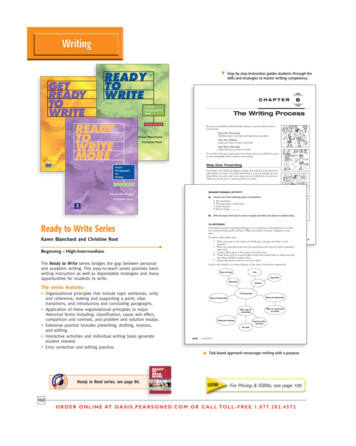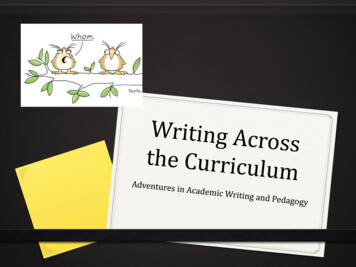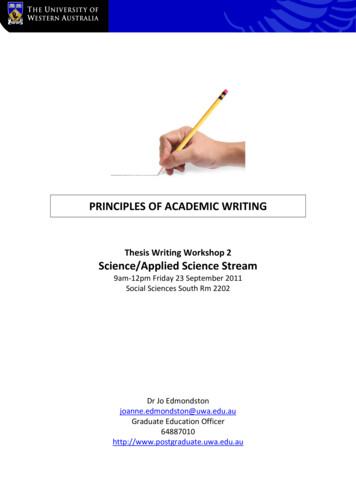
Transcription
PRINCIPLES OF ACADEMIC WRITINGThesis Writing Workshop 2Science/Applied Science Stream9am‐12pm Friday 23 September 2011Social Sciences South Rm 2202Dr Jo Edmondstonjoanne.edmondston@uwa.edu.auGraduate Education Officer64887010http://www.postgraduate.uwa.edu.au
Objectives Workshop 1: To discuss the purpose of a thesis To determine the elements of a good thesis To discuss how different theses are organised To provide strategies to equip you to write a good thesisObjectives Workshop 2: To consider strategies for writing a thesis that has a logical structure andcommunicates effectively To consider sentence and paragraph structure To demonstrate the essential components of an introductionObjectives Workshop 3: To explore writing as a process To practice using strategies to facilitate your continued writingWorkshop plan9.00 – 9.30Reflecting on writing9.30 – 10.15Good sentences10.15 – 10.30Break10.30 – 11.15Good paragraphs11.15 – 11.45Structuring Introductions11.45 – 12.00Evaluation and closeAcknowledgementsThis workshop booklet is adapted from Krys Haq’s & Michael Azariadis workshopnotes. Krys thanks Writer’s Liberation Front members Dr Jennifer Davis and HelenaClayton, respectively, for finding the Gopen & Swan 1990 reference and for passing iton to her.1
Reflecting on academic writing skillsHow do you think academic writing (scientific writing / technical writing) for yourthesis differs from writing you have done previously?What thesis writing skills do you have?What do you find difficult when you are writing? What skills do you need todevelop?2
Features of ‘good’ academic writingAim for a thesis that is easy to read (accessible), interesting & intellectually rigorousIn this order of importance: Precise & complete – conscious choice of words that conveys exact andcomplete meaning. Don’t leave your reader thinking ‘What?’ or ‘So what?’ Clear – simple language with exception of required technical terms Brief – as short as possible, avoiding unnecessary words or sentences(repetition & redundancy)And also: Effective structure – good use of sentences & paragraphs and well organisedsections, chapters & thesis Correct spelling and grammar – more important to clearly express andlogically order ideas, as once message is clearly communicated someone elsecan help you correct spelling and grammar Simple, clear illustrations – indicative of ‘higher order’ thinking / moresophisticated understanding Follows disciplinary conventions – before deviating from convention makesure you know what the convention is Interesting[Adapted from Dr Juniper’s powerpoint presentation ‘Writing your Thesis’. rney/writing]Consider the micro and macro structure of your thesis. Review how these elementslink together & their internal persThesis3
Simple writing exercisesExample: A sentence with too much information. Edit by the inclusion of full stopsinto manageable sentences. (Hint: Read this aloud).The level of demand on the commitment and ability ofcommunities to undertake coordinated and targeted actionin Natural Resource Management has increased over thelast two decades and there has been recognition of theneed to develop community capacity to meet these newchallenges yet there is little evidence of considerationof the notions of communities that can be derived from arich, if fluctuating, history of community research.Example: Sentences that are unnecessarily ‘wordy’. Remove any unnecessary text.From analysing the data presented in Table 2 the resultsshow that sample A is higher in sodium levels than sampleB.Example: Sentences that are incomplete – include information that addresses ‘Sowhat?’ and clearly indicates what is the point of reference is.Although many of these instruments are commonly appliedto the assessment of learning in young children, theyhave a number of potential limitations. Childhoodlearning is important because .Example: Sentences with multiple interpretations (meanings). What would be amore precise way to write these sentences?Sample X was chilled.Patient 3 had an incurable disease.4
Writing wellDo not aim to impress .“ If the writing is clear and simple, fellow scientists will not only find your writingpleasanter to read, but they will also think you are a better scientist, have a betterorganised mind, and are more competent. Readers seem less and less prepared toaccept the traditional smokescreen. If they can understand easily, they are morelikely to be impressed with the quality of the thought behind the words”. (Turk &Kirkman, 1989, p. 18) aim to communicate.“It does not matter how pleased an author might be to have converted all the rightdata into sentences and paragraphs; it matters only whether a large majority of thereading audience accurately perceives what the author had in mind.” (Gopen andSwan, 1990, p. 550)Writing can be structured to support readers to predict what will come next ‐ wellwritten work is structured so that readers are guided in what will follow, and theirexpectations are actually fulfilled.“If the reader is to grasp what the writer means, the writer must understand whatthe reader needs.” (Gopen and Swan, 1990, p. 550)What does the reader need? Readers actively seek a basis for prediction Readers form expectations based both on topic and organisation Reader predictions are based on words that are read (from the top) Topic predictions may be fulfilled by word repetition, predictable word groups,disciplinary conventions Items that fulfil reader predictions need to be in a noticeable position; at thefront of the text unit Readers expect to continue predicting until the final section Readers become confused when predictions are not fulfilled Unpredicted/unpredictable topics increase reader difficulty[Adapted from Lawe‐Davies, 2001]Academic writing is very different to fiction – there should be not twists or turns ofthe plot and no surprise endings.5
Writing sentences ‐ important structural principlesMake your sentences accessible and clear, without minimizing the complexity ofideas conveyed.Positioning words a sentence should focus on a single item place the object of focus at the beginning of the sentence – in the ‘topic position’ follow the object of focus as closely as possible with its verb place new information you want to emphasize to the reader at the end of thesentence – in the ‘stress position’ choose a verb to articulate action in every clause or sentence avoid ‘noun clusters’ or ‘stacked modifiers’Linking sentences in general, provide context for your reader before asking that reader to consideranything new place information presented in previous sentences in the topic position toprovide link between old and new sentences and set the context for the newsentence ‐ linkage backward and contextualization forward use transition words to guide the reader – these words allow the reader tofollow your connection of items/ideas try to ensure that the sentence coincides with the relative expectations foremphasis indicated by the structureGeneral guidelines make sure your sentence is complete ‐ don’t leave the reader with a sense of ‘Sowhat?’ Either follow with an explanation or expand sentence to explainsignificance of sentence.Handouts provided at workshop:Grammatical Terms: some definitionsTransitional Words and Other Useful Words and PhrasesConnectives6
Some difficult sentences and modifications that make them more comprehensible[Adapted from Gopen & Swan, 1999]Example:The smallest of the URF’s (URFA6L), a 207-nucleotide (nt)reading frame overlapping out of phase the NH2-terminalportion of the adenosinetriphosphatase (ATPase) subunit 6gene has been identified as the animal equivalent of therecently discovered yeast H -ATPase subunit 8 gene.The smallest of the URF’s, URFA6L, has been identified as the animal equivalent ofthe recently discovered yeast H ‐ATPase subunit 8 gene. This URF has a 207‐nucleotide (nt) reading frame that overlaps, but is out of‐phase, with the NH2‐terminal portion of the adenosinetriphosphatase (ATPase) subunit 6 gene.Example :Recently, however, immunoprecipitation experiments withantibodies to purified, bovine heart rotenone-sensitiveNADH-ubiquinone oxido-reductase (also known as ComplexI), as well as enzyme fractionation studies haveindicated that six human URF’s (that is, URF1, URF2,URF3, URF4, URF4, and URF5) encode subunits of Complex Iwhich is a large complex that also contains many subunitssynthesized in the cytoplasm.Recently however, several human URF’s have been shown to encode subunits ofrotenone‐sensitive NADH‐ubiquinone oxido‐reductase (also known as Complex I).Complex I is large and that contains many subunits synthesized in the cytoplasm. Sixsubunits of Complex I were shown by enzyme fractionation studies andimmunopreciptation experiments to be encoded by six human URF’s (URF1‐5).7
Example – modifying sentences by adding verbs to articulate the action beingdescribed in the text:Transcription of the 5S RNA genes in the egg extract isTFIIIA-dependent. This is surprising, because theconcentration of TFIIIA is the same as in the oocytenuclear extract. The other transcription factors and RNApolymerase III are presumed to be in excess overavailable TFIIIA, because tRNA genes are transcribed inthe egg extract. The addition of egg extract to theoocyte nuclear extract has two effects on transcriptionefficiency. First, there is a general inhibition oftranscription that can be alleviated in part bysupplementation with high concentrations of RNApolymerase III. Second, egg extract destabilizestranscription complexes formed with oocyte but notsomatic 5S RNA genes.In the egg extract, the availability of TFIIIA limits transcription of the 5S RNA genes.This is surprising because the same concentration of TFIIIA does not limittranscription in the oocyte nuclear extract. In the egg extract, transcription is notlimited by RNA polymerase or other factors because transcription of tRNA genesindicates that these factors are in excess of available TFIIIA. When added to thenuclear extract, the egg extract affected the efficiency of transcription in two ways.First, it inhibited transcription generally; this inhibition could be alleviated in part bysupplementing the mixture with high concentration of RNA polymerase III. Second,the egg extract destabilized transcription complexes formed by oocyte but not bysomatic 5S genes.8
Example – Effective Transitions & SignpostsConsider the first 3 paragraphs of Matthew Simpson’s high quality PhD Thesis AnAnalysis of Unconfined Ground Water Flow Characteristics near a Seepage‐FaceBoundaryParagraph 1Ground water flow occurs under conditions that areusually classified as being either confined orunconfined. Confined ground water flow is Conversely,unconfined flow The structure is clearly signposted by the use of “either ‐ or” and “conversely”,and repetition, in correct order, of the terms “confined” and “unconfined”Paragraph 2The quantification of unconfined flow processes. Thejustification for ignoring the vertical processes is thatthe horizontal length scale of a typical unconfinedaquifer is much larger than the vertical, i.e. L H inFig 1-1.Therefore Repetition of key words provides a link between paragraphs An argument is signposted, and the reader is referred to a Figure that makes thepoint visually. The consequence of the argument is also explained.Paragraph 3:Several analysts have expressed reservation abouthorizontal flow modelling strategies; forexample Although these reservations have been voiced,other researchers have shown that Therefore A point is made and an illustration signposted. The words “although” and“other” indicate that controversy is being discussed. The word “therefore”signposts an outcome of the controversy or a conclusion.9
Writing paragraphs ‐ important structural principlesGood, focussed writing is underpinned by a clear paragraph structure.Paragraphs ‘break up’ the information you want to present to your reader,structuring it in such a way that guides the reader through a series of related ideas.Academic paragraphs follow what is known as a ‘general‐to‐specific’ sequencewhereby they begin with a general (or topic) sentence and become increasinglyfocused on information which contributes to your argument.A clear topic sentence is essential to a good paragraph. Topic sentences tell thereader what your paragraph is about, and help prepare them for what you will thensay.Steps to writing good academic paragraphs Select a topic for your paragraph and a key question that your paragraph willanswer. For example the topic may be “features of good academicparagraphs” and a key question might be “what are the features?” Decide on the answer to your question. You may need to do some mindmapping or even free writing to sort out your thoughts first. Use your own words to write a sentence that is a simple and direct answer tothe key question. For example “Good academic paragraphs contain a cleartopic sentence, cohesive support, convincing argumentation, and goodexpression.” Write a cohesive set of supporting sentences. They should be well orderedand contain appropriate transition signals. Make your answer as convincing as possible through effective argumentation‐ use evidence (research data, statistics, expert opinion) and logic. Explain,exemplify and justify your answer. Check your paragraph for good expression, grammar, spelling, punctuation,capitalisation and referencing.10
Example:Consider the following version of an Introduction to a scientific paper.Various Eulerian link-node models have been developed forthe simulation of transport for water quality modelling.For example, Tim et al (2003), Jin et al (1998), Lung andLarson (1995), Gu and Dong (1998) used WASP5 for waterquality modelling in rivers and lakes. Barnell et al(2004) and Melching et al (1994) used QUAL2E for riverwater quality modelling. However, the Eulerian modelscontain an undesirably large amount of numericaldiffusion in the advection simulation (refs) and arefound unsatisfactory for transport and water qualitymodelling. Also, due to the limitations in time steps,Eulerian models may not be suitable for long termsimulations of large river systems. In the Lagrangianframe, as the control volumes are moved with the meanflow velocity, numerical diffusion associated withadvection is totally eliminated and accurate modelling oftransport and water quality may be achieved. Further, aLagrangian model allows a large time step so that a longterm simulation may be achieved.Can you list the points the author is making?What is he arguing?How might you restructure this to make his arguments clearer to the reader?Example:Read through O’Beirne’s Abstract for the UWA PhD in Physiology “Mathematicalmodelling and electrophysiological monitoring of the regulation of cochlearamplification.Consider how he has structured his paragraphs & used signposting to guide thereader through the text.11
Structuring Introductions – 3 Essential Moves1. Establish a research territory by:Showing that the research area is important, problematic or relevant in some wayand introducing previous work in the area“How students perceive their learning environments haslong been accepted as having a significant influence onthe quality of the students’ learning outcomes (Doyle,1997; Fraser, 1989; Ramsden, 1992; Walberg, 1971). Overthe past quarter century an extensive empirical base hasbeen developed The ultimate aim of most of this researchhas been to ”2. Establish a context in which your research makes sense by:Defining a problem or question that needs to be answered“Although .[past work described in the precedingparagraph] is psychometrically sound, [it has] a numberof potential limitations. First, there is always aconcern that . Second, the instruments [used inmeasurement] focus on just one type of learningenvironment Third [these instruments] . may deny thecomplexity of classroom life. And fourth, the instrumentsdo not investigate why ”3. State what you will do in relation to the problem or question by:Outlining the objectives of your research, what do you propose as the solution to theproblem identified above, andIndicating the structure and scope of the paper.“This paper reports on the use of the Perceptions ofLearning Environments Questionnaire which uses a semistructured format to gather student perceptions Thisseeks to address the limitations of existing instrumentsoutlined above. The outcomes of the data collectionreported here are used to produce student views of goodand bad teaching which are then evaluated in terms ofcontemporary ideas about effective teaching.”[Examples taken from Clarke, 1995].12
Exercise:Write three well structured introductory paragraphs on the topic “What is goodacademic writing?” Once you have finished, share what you have written with othersat your Table, and give constructive feedback to develop a piece of well written text.13
References Clark, J. 1995. Tertiary Students' Perceptions of their Learning Environments:A New Procedure and Some Outcomes. Higher Education Research &Development, 1469‐8366, Volume 14, Issue 1, 1995, Pages 1 – 12. Evans, D and P Gruba. 2002. How to Write a Better Thesis MelbourneUniversity Press Flesch, R.F. 1962. The Art of Readable Writing (available from the Humanitiesand Social Science Library, 808.042 Art) Gowers, E. 1973. The Complete Plain Words (available from the Humanitiesand Social Science Library, 808 1973) Harvey, G. 1998 Writing with Sources: a guide for students Hackett PublishingCompany How to recognise plagiarism http://www.indiana.edu/ istd/sitemap.html Lindsay, D. 1995. A Guide to Scientific Writing, Longman Murphy, E. 1985. You Can Write Longman Report Writing Style Guide for Engineering ic/report‐engineering.pdf The Style Manual for authors, editors and printers. 2002. John Wiley andSons, Australia Ltd. ( Prepared for the Commonwealth Department of Financeand Administration) Truss, L. 2003. Eats, Shoots and Leaves: The Zero Tolerance Approach toPunctuation Profile Books, London Lawe Davies. 2001. Coherence in tertiary student writing. Writers skills andreaders’ expectations. PhD Thesis, UWA. Turk, C and J Kirkman. 1989. Effective Writing. Improving scientific, technicaland business communication. 2nd edition. E&FN Spon, London. Gopen, G. D. and Swan, J.A. 1990. The Science of Scientific Writing AmericanScientist, Vol 78, no. 6, pp. .14
Final words .Useful as general rule of thumb but not a guiding principle: Paragraphs on average are 100 words long (50 – 250 words) Sentences on average are 25 words long Sentences/ paragraphs that are too long may indicate a lack of focus ‐rambling Sentences/ paragraphs that are too short may indicate underdeveloped ideas‐ bittyGrammarSee StudySmarterSpellingDon’t rely on your spellcheckerTaken from Hans Lambers 2007 powerpoint presentation “Publishing a ScientificPaper” See: y/writingI have a spell checker, it came with my PC, it plainly marks for my review, mistakes Icannot see.15
PhD theses examples:Beesley, Leah. 2006. Environmental stability: its role in structuring fish communitiesand life history strategies in the Fortescue River, Western Australia. PhD AnimalBiology, UWA.D’Emden, Francis. 2006. Adoption of conservation tillage: an application of durationanalysis. Masters Science Agriculture, UWA.Goddard‐Borger, Ethan. 2008. Some synthetic carbohydrate chemistry. Naturalproduct synthesis, rational inhibitor design and the development of a new reagent.PhD Chemistry, UWA.Gottardo, Nicholas. 2008. Oncogenes and prognosis in childhood T‐cell acutelymphoblastic leukaemia. PhD Paediatrics and Child Health, UWA.Jones, Christopher. 2007. Laser scanning confocal arthroscopy in orthopaedics:examination of the chondrial and connective tissues, quantification of chondrocytemorphology, investigation of matrix induced autologous chondrocyte implantationand characterisation of osteoarthritis. ADT WU2008.0061Jones, Christopher. 2008. The best of Santalum album: essential oil composition,biosynthesis and genetic diversity in the Australian tropical sandalwood collection.PhD Plant Biology, UWA.O’Beirne, Greg. 2005. Mathematical modelling and electrophysical monitoring of theregulation of cochlear amplification. Masters Clinical Audiology, UWA.O’Mara, David. 2002. Automated facial metrology. PhD Computer Science andSoftware Engineering, UWA.Simpson, Matthew. 1998. An analysis of unconfined ground water flowcharacteristics near a seepage‐face boundary. PhD Environmental Engineering,UWA.Stanwix, Paul. 2007. Testing local Lorentz invariance in electrodynamics. PhD Physics,UWA.16
nucleotide (nt) reading frame that overlaps, but is out of‐phase, with the NH2‐ terminal portion of the adenosinetriphosphatase (ATPase) subunit 6 gene. Example : Recently, however, immunoprecipitation experiments with antibodies to purified, bovine heart rotenone-sensitive
